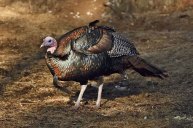Kansas turkey hunters' hopes for this hunting season have been dashed: Because of declining state and regional wild turkey population levels, officials have suspended the season. Over four public meetings, the Kansas Wildlife and Parks Commission heard recommendations from staff which led to them decide that full suspension of the fall turkey hunting season was the best choice to help the population rebound.
"We've documented consistent declines in turkey populations over the last 15 years largely due to reduced production levels," Kent Fricke, KDWP small game biologist, said in a press release. "These trends are not unique to Kansas. States across the Midwest and Southeast have experienced similar patterns in turkey populations."
Kansas doesn't see nearly as many turkey hunters in their fall season compared to the spring, so the effect won't be felt too heavily on the community. At the same time, biologists still believe protecting the pre-winter numbers will help: "The estimated statewide fall harvest of turkey was less than 500 birds in 2022," Fricke said. "While this is a small proportion of the statewide population, fall harvest is an additive source of mortality for turkeys, especially when hens are harvested."
Due to low population numbers, the KDWP and the National Wild Turkey Federation are funding a population research project at Kansas State University in January 2024.
Kansas' main subspecies is the Rio Grande, but they also have hybrid Rio Grande/Eastern turkeys in their northwest and southeast regions.
The United States has six main wild turkey species: Eastern, Osceola, Merriams, Rio Grande, Goulds, and Ocellated turkeys. Overall there are between six to seven million wild turkeys across the U.S. living in every state except Alaska. Some states have modest populations, like Delaware, with around 6,000, and Arizona's 25,000.
Meanwhile, other states have massive populations of 200,000 or more, like Florida, California, Alabama, and Minnesota. In fact, wild turkeys are considered to be a conservation success story. At one point, these feathered birds were almost extinct, but the reforestation and reintroduction programs have them thriving again in almost every state.
Hopefully, with these protective measures, the same will be said for Kansas in the years to come.
READ MORE: What Do Wild Turkeys Eat? And Other Interesting Things About the Game Bird




